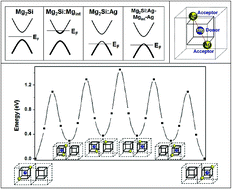Interplay between Ag and interstitial Mg on the p-type characteristics of Ag-doped Mg2Si: challenges for high hole conductivity
Abstract
Although Mg2Si has been considered to be a highly promising material for low-cost thermoelectric harvest of waste heat at intermediate temperatures, the great difficulty in doping Mg2Si into an effective p-type semiconductor poses a major technical barrier against utilizing the material to realize efficient devices. Here we attempt for the first time to elaborate its significantly different responses to n- and p-type doping, through theoretical investigation of the best p-type doped system, the Ag-doped Mg2Si. Using the Heyd–Scuseria–Ernzerhof (HSE) hybrid functional, we find that fundamentally the p-type characteristics of Ag-doped Mg2Si tend to be achieved through linear clustering between Ag and interstitial Mg (i.e. Ag–Mgint–Ag) in the 〈111〉 direction in the Mg2Si lattice, via strong interactions between donor (interstitial Mg, Mgint) and acceptor (substitutional Ag) states. Such a donor–acceptor interaction leads to lowered hole concentration, on top of the outcome that the Ag-induced hole mobility is only 10% of the electron mobility in the best n-type material, the Sn-doped Mg2Si. The current work suggests that it is rather challenging to achieve high hole conductivity in Ag-doped Mg2Si, unless native defects particularly the interstitial Mg atoms can be avoided during the synthesis stage or eliminated through subsequent equilibration treatment.


 Please wait while we load your content...
Please wait while we load your content...